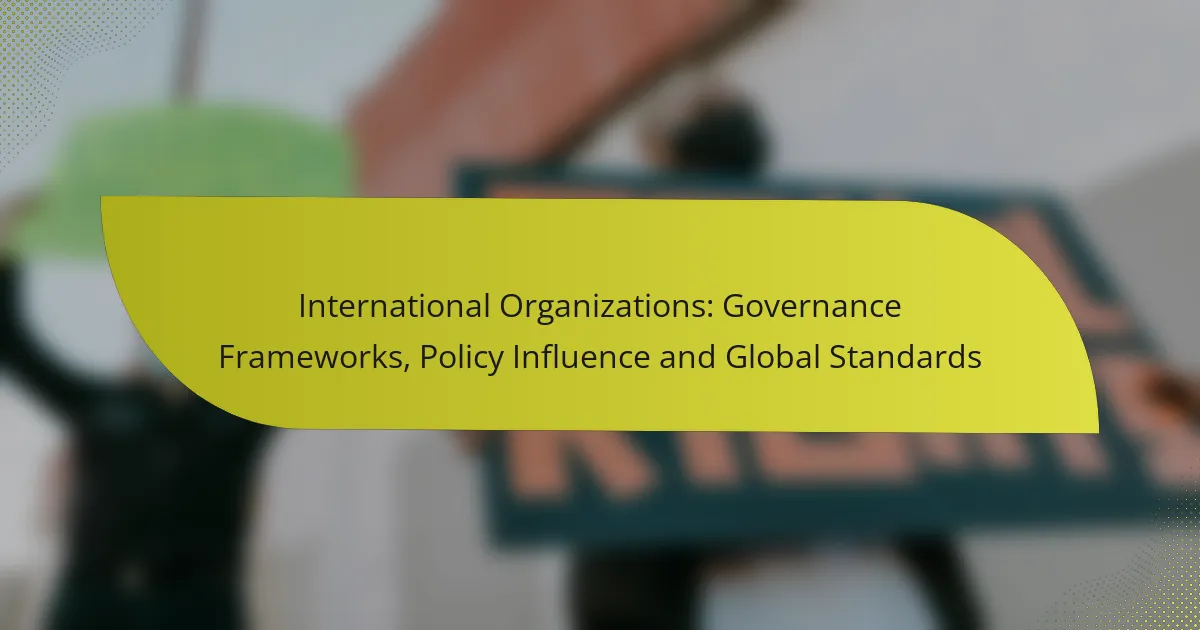International organizations play a crucial role in shaping global governance by creating frameworks that guide policy-making and foster international cooperation. Through structured governance approaches, they influence global standards and address pressing international challenges across sectors such as trade, economic stability, and humanitarian efforts.
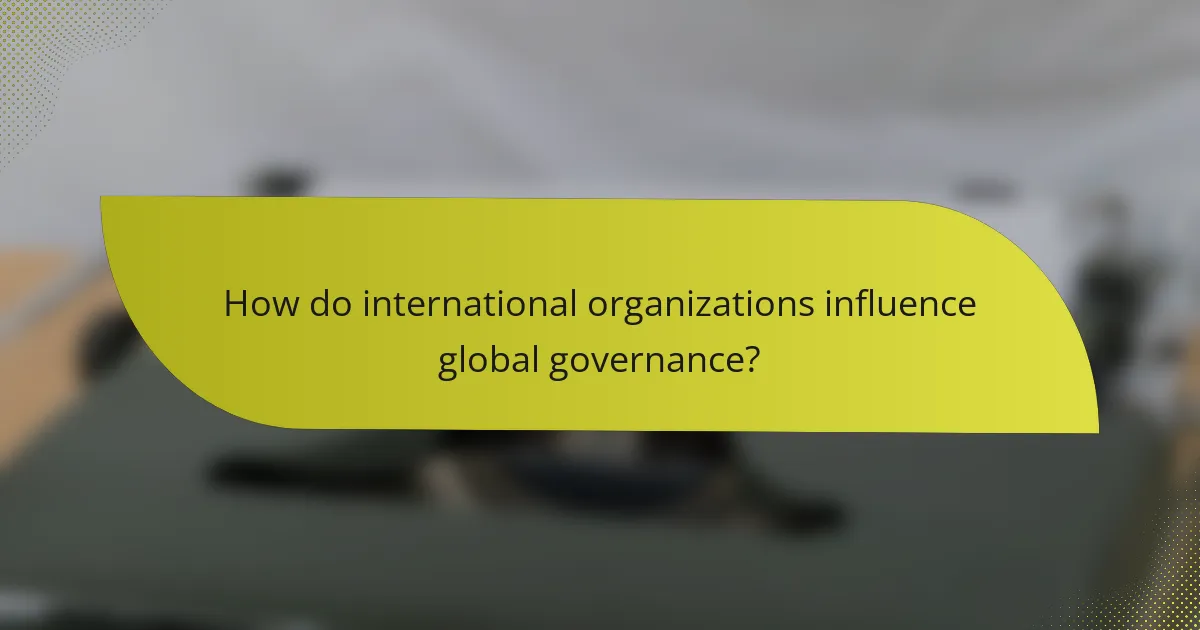
How do international organizations influence global governance?
International organizations shape global governance by establishing frameworks that guide policy-making, promote cooperation, and set standards across nations. Their influence is evident in various sectors, including trade, economic stability, and humanitarian efforts.
United Nations’ role in global policy
The United Nations (UN) plays a critical role in global policy by facilitating dialogue among member states and promoting international norms. Through various agencies, such as the UN Development Programme and the World Health Organization, the UN addresses issues like poverty, health, and human rights.
By setting agendas and providing platforms for negotiation, the UN influences national policies and encourages countries to adopt practices that align with global standards. For instance, the Sustainable Development Goals (SDGs) serve as a framework for countries to align their development strategies with global priorities.
World Trade Organization’s impact on trade regulations
The World Trade Organization (WTO) significantly impacts trade regulations by establishing rules that govern international trade. It aims to ensure that trade flows as smoothly, predictably, and freely as possible, which is crucial for economic growth.
WTO agreements cover various aspects of trade, including tariffs, subsidies, and intellectual property. By providing a platform for trade negotiations and dispute resolution, the WTO helps member countries navigate trade challenges and encourages compliance with established regulations.
International Monetary Fund’s influence on economic policies
The International Monetary Fund (IMF) influences economic policies by providing financial assistance and policy advice to member countries facing economic instability. Its role is crucial in promoting global financial stability and sustainable economic growth.
Through programs like the Extended Fund Facility, the IMF offers loans to countries in exchange for implementing specific economic reforms. These reforms often focus on fiscal discipline, structural adjustments, and monetary policy changes, helping countries stabilize their economies and restore growth.
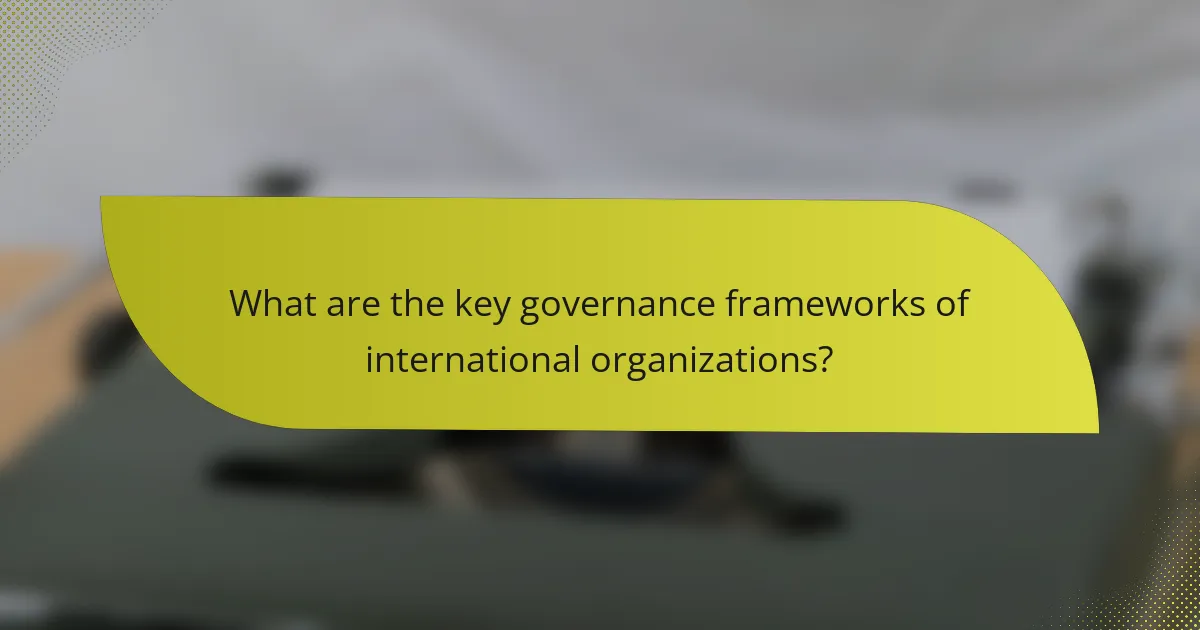
What are the key governance frameworks of international organizations?
Key governance frameworks of international organizations provide structured approaches to decision-making, accountability, and policy implementation. These frameworks guide how organizations operate, influence global standards, and address international challenges.
UN’s Sustainable Development Goals framework
The UN’s Sustainable Development Goals (SDGs) framework consists of 17 interconnected goals aimed at addressing global challenges such as poverty, inequality, and climate change. Each goal is accompanied by specific targets and indicators to measure progress, fostering accountability among member states.
Countries are encouraged to integrate the SDGs into their national policies, aligning their development strategies with these global objectives. For instance, nations may prioritize clean energy initiatives to meet Goal 7, which focuses on affordable and clean energy access.
OECD’s governance principles
The OECD’s governance principles emphasize transparency, accountability, and stakeholder engagement in public governance. These principles serve as a guideline for governments to enhance their decision-making processes and improve public sector performance.
For example, countries implementing OECD principles may adopt measures such as open data initiatives to promote transparency and public participation in governance. This can lead to better policy outcomes and increased trust in government institutions.
World Health Organization’s health governance
The World Health Organization (WHO) establishes health governance frameworks that guide global health policies and responses to health emergencies. These frameworks focus on collaboration among member states to improve health systems and ensure equitable access to healthcare.
During health crises, such as the COVID-19 pandemic, the WHO’s governance framework facilitates coordinated responses, sharing of information, and resource allocation among countries. Adhering to WHO guidelines can help nations strengthen their health infrastructures and improve public health outcomes.

How do international organizations set global standards?
International organizations set global standards through collaborative frameworks that involve member states, industry experts, and stakeholders. These standards aim to ensure consistency, safety, and quality across various sectors worldwide.
ISO standards for quality management
The International Organization for Standardization (ISO) develops standards that enhance quality management practices across industries. ISO 9001, for instance, outlines criteria for a quality management system, helping organizations improve efficiency and customer satisfaction.
Implementing ISO standards typically involves a systematic approach, including defining processes, setting objectives, and conducting regular audits. Organizations should ensure they engage all relevant stakeholders during this process to foster buy-in and compliance.
FAO food safety standards
The Food and Agriculture Organization (FAO) establishes food safety standards to protect consumer health and ensure fair practices in food trade. These standards, such as the Codex Alimentarius, provide guidelines on food hygiene, labeling, and pesticide residues.
Countries adopting FAO standards often see improvements in food safety and trade facilitation. It is crucial for food producers to stay updated on these standards to avoid non-compliance, which can lead to trade barriers and health risks.
ITU telecommunications standards
The International Telecommunication Union (ITU) sets telecommunications standards that ensure interoperability and efficiency in global communication networks. These standards cover various aspects, including network architecture, security protocols, and spectrum management.
Adhering to ITU standards helps countries and companies enhance their telecommunications infrastructure. Stakeholders should regularly review and adapt to these standards to keep pace with technological advancements and regulatory changes.
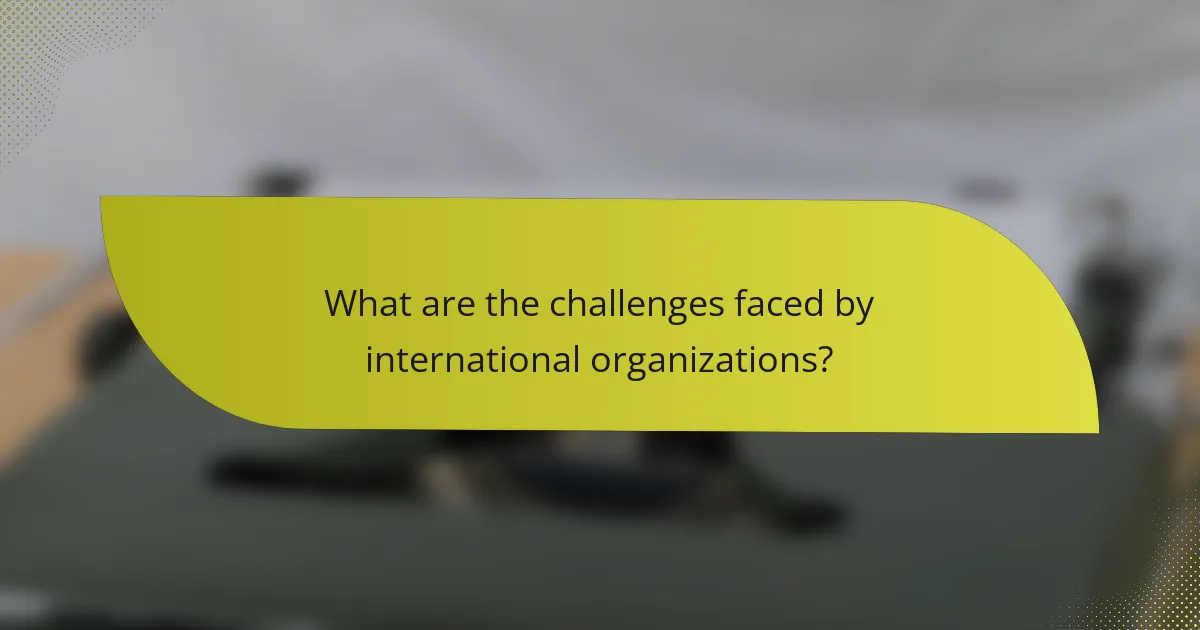
What are the challenges faced by international organizations?
International organizations encounter various challenges that can hinder their effectiveness, including political influence, funding issues, and compliance difficulties. These obstacles can affect their ability to implement policies and maintain global standards.
Political influence and bias
Political influence and bias can significantly impact the decision-making processes within international organizations. Member states often exert pressure to align outcomes with their national interests, which can lead to skewed policies that do not reflect a balanced global perspective.
For example, larger nations may dominate discussions, resulting in decisions that favor their agendas over those of smaller or less powerful countries. This imbalance can undermine the credibility and authority of the organization.
Funding and resource allocation issues
Funding and resource allocation are critical challenges for international organizations, as they often rely on contributions from member states. Fluctuations in funding can lead to resource shortages, impacting the organization’s ability to carry out its mission effectively.
Moreover, disparities in contributions can create tension among member states, with some countries feeling overburdened while others contribute minimally. This can affect collaboration and the overall effectiveness of initiatives.
Compliance and enforcement difficulties
Compliance and enforcement are significant hurdles for international organizations, as they typically lack the authority to impose sanctions or enforce regulations. This limitation makes it challenging to ensure that member states adhere to agreed-upon standards and policies.
For instance, without robust enforcement mechanisms, countries may choose to ignore international agreements, leading to inconsistent application of global standards. This can diminish the organization’s impact and effectiveness in addressing global issues.
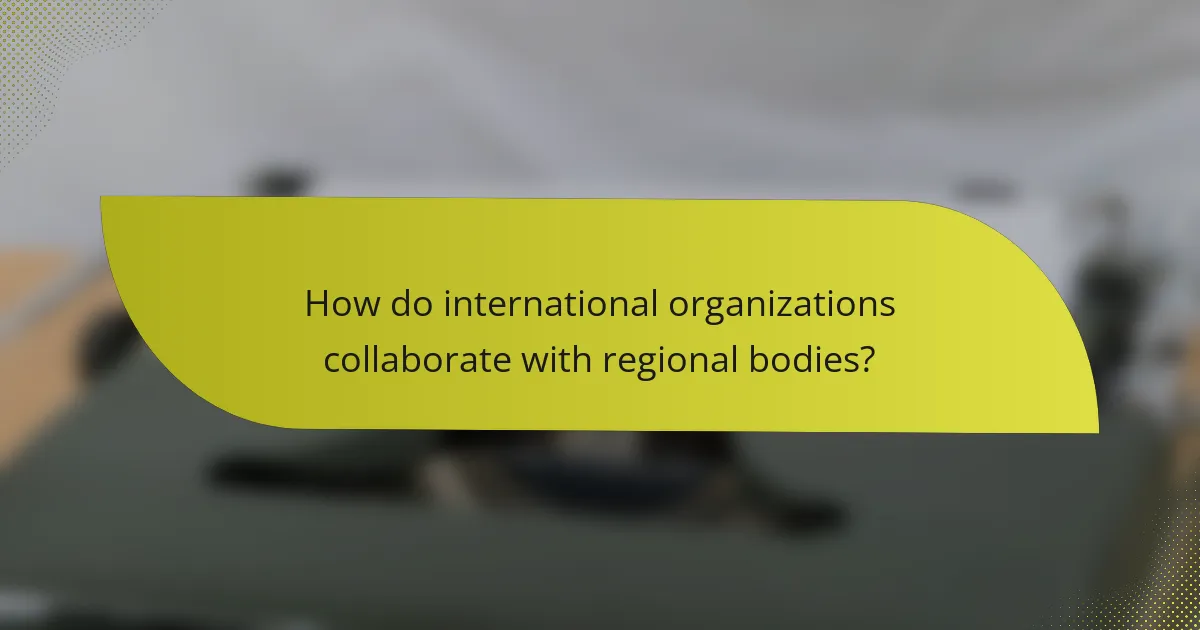
How do international organizations collaborate with regional bodies?
International organizations collaborate with regional bodies to enhance governance, share resources, and align policies across different levels. This partnership often involves joint initiatives, funding mechanisms, and coordinated responses to global challenges.
EU’s partnership with the United Nations
The European Union (EU) collaborates with the United Nations (UN) to address global issues such as climate change, human rights, and sustainable development. This partnership is exemplified by the EU’s commitment to the 2030 Agenda for Sustainable Development, which aligns EU policies with UN goals.
Joint initiatives often involve funding from the EU to support UN programs, particularly in areas like humanitarian aid and peacekeeping missions. The EU also participates in UN forums to influence global standards and policies, ensuring that European interests are represented on the world stage.
African Union’s collaboration with the African Development Bank
The African Union (AU) works closely with the African Development Bank (AfDB) to promote economic development and regional integration across Africa. This collaboration focuses on funding infrastructure projects, enhancing trade, and improving governance within member states.
Through joint programs, the AU and AfDB aim to mobilize resources for projects that align with the AU’s Agenda 2063, which envisions a prosperous and integrated Africa. This partnership also emphasizes capacity building and technical assistance to help member states implement effective policies and reforms.
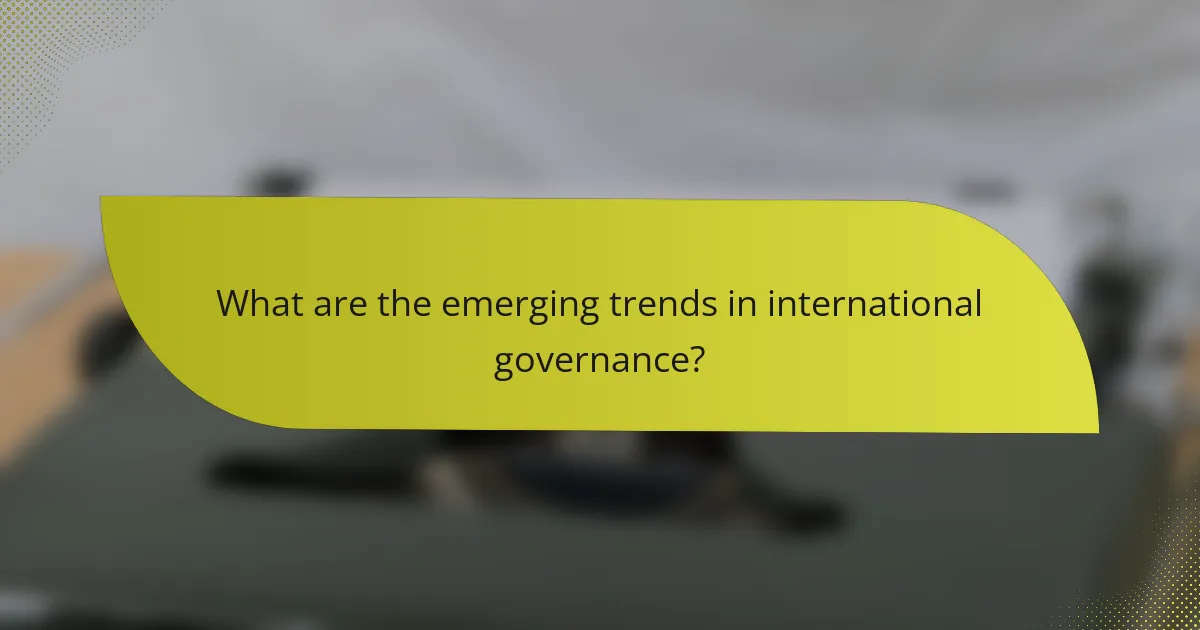
What are the emerging trends in international governance?
Emerging trends in international governance reflect a shift towards more collaborative and responsive frameworks, particularly in addressing global challenges. Key areas of focus include climate change, digital governance, and the increasing influence of non-state actors.
Increased focus on climate change policies
International governance is increasingly prioritizing climate change policies as nations recognize the urgent need for collective action. This trend is driven by commitments made under agreements like the Paris Accord, which aim to limit global warming and promote sustainable practices.
Countries are adopting various strategies to meet climate targets, including carbon pricing, renewable energy incentives, and stricter regulations on emissions. For instance, the European Union has implemented the European Green Deal, aiming to make Europe the first climate-neutral continent by 2050.
Organizations and governments should consider integrating climate policies into their governance frameworks. This includes engaging stakeholders from multiple sectors, investing in green technologies, and monitoring progress against established benchmarks to ensure accountability and transparency.
